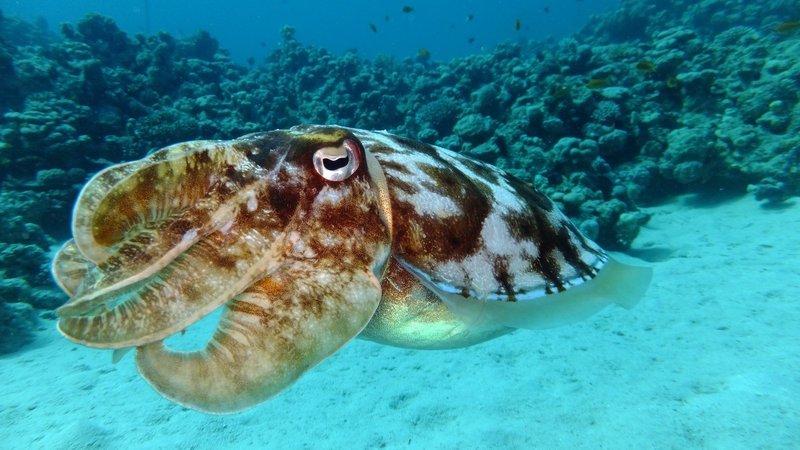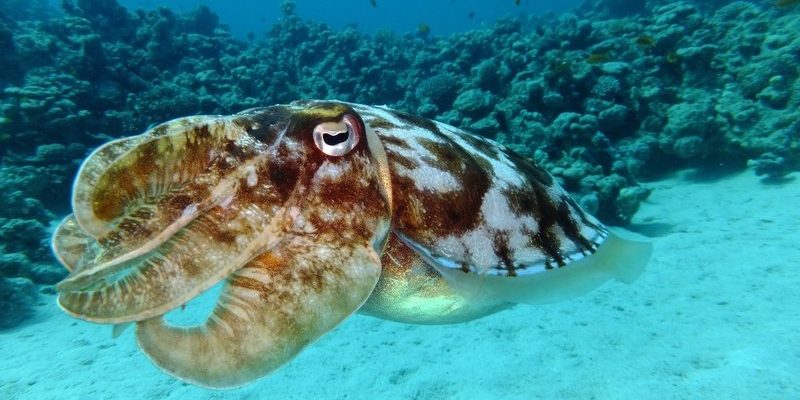
If you’re curious about these underwater marvels, you’re in for a treat! In this article, we’re diving into the top ten fascinating facts about squids that will leave you amazed. Get ready to learn about their intelligence, unique abilities, and how they fit into the ocean’s ecosystem. Let’s explore this magical world together!
1. Squids Are Masters of Disguise
One of the most captivating features of squids is their ability to change color and texture. Imagine a magician who can transform their appearance in the blink of an eye. Squids use special cells in their skin called chromatophores to achieve this. These tiny pigment-containing cells expand or contract, allowing squids to blend in seamlessly with their surroundings.
This skill isn’t just for show; it’s a survival tactic. By changing colors, squids can camouflage themselves from predators, making it harder to be seen. They can also use bright colors as a warning to potential threats or to communicate with each other. Honestly, it’s like being part of an underwater fashion show where the stakes are survival!
Why Camouflage Matters
The ability to camouflage is vital for squids living in oceans filled with predators and prey. For example, a squid resting on a coral reef can shift its colors to match the vibrant blues and greens of the coral, making it nearly invisible. This ability not only helps them avoid becoming dinner but also allows them to sneak up on unsuspecting prey.
2. They Have a Complex Nervous System
You might be surprised to learn that squids boast one of the most advanced nervous systems among invertebrates. Their brains are surprisingly large in relation to their body size, which gives them remarkable cognitive abilities. It’s almost like they have a mini computer running the show!
Squids are known to exhibit behaviors that suggest problem-solving skills. For instance, they can navigate complex mazes and even learn to open jars to access food. It’s like they’ve got a little bit of genius hidden in those squishy bodies!
What This Means for Squid Behavior
The sophisticated nervous system allows squids to engage in a variety of behaviors, such as hunting and escaping predators effectively. They also show signs of curiosity and playfulness, which are traits we usually associate with more complex animals, like dolphins. Who knew that the ocean’s mysterious depths were home to such intelligent creatures?
3. Their Movement is Impressive
When it comes to speed and agility, squids are like the race cars of the ocean. Equipped with a unique jet propulsion mechanism, they can move swiftly through the water. By taking in water and then forcefully expelling it, squids can propel themselves away from danger almost instantly.
Imagine a sprinter at the starting line. The moment the race begins, they take off with a burst of energy. That’s how squids escape from predators like sharks or larger fish! Their ability to zip around makes them not just agile hunters but also hard-to-catch prey.
The Benefits of Jet Propulsion
This method of movement isn’t just fast; it’s also efficient. Squids can accelerate quickly with minimal effort, conserving energy for those necessary bursts of speed. This makes hunting easier and helps them evade predators when needed. It’s a clever adaptation for survival in the ocean’s unpredictable landscape.
4. They Have Unique Anatomical Features
Squids are not just strange blobs of muscle; they have some unique anatomical features that make them truly fascinating. For starters, their beaks are similar to those of birds. These beaks are incredibly strong and can slice through the shells of crabs and other hard-shelled prey. Think of them like a pair of super-efficient scissors!
Another interesting feature is their three hearts. Yep, you read that right! Two of these hearts pump blood to the gills, where oxygen is absorbed, while the third heart pumps it to the rest of the body. That’s a lot of love in the ocean!
Why These Features Matter
These anatomical adaptations are crucial for a squid’s survival. The beak allows them to efficiently access food, while their multiple hearts help ensure they can thrive in varying environments, even in the deep sea where oxygen levels might be low. Squids are perfectly designed for life in the ocean!
5. Squids Can Live Long Lives
You might think of squids as short-lived creatures, but some species can actually live a lot longer than you’d expect. While many squids have a lifespan of just a few years, some deep-sea varieties can live up to 15 years! That’s quite impressive for a creature that’s often overshadowed by flashier sea life.
Their longevity varies based on their species and environment. For example, the giant squid, famous for its size and mythical status, can take years to fully mature. This slow maturation means they can stick around longer than many of their smaller cousins.
How Longevity Affects Their Role in Ocean Ecosystems
Longer lifespans allow squids to contribute significantly to their ecosystems. They can help maintain balance in their environments by acting as both predator and prey. This dynamic role makes them vital players in ocean health, showcasing the importance of every species, no matter how small.
6. They Are Excellent Hunters
With their keen eyesight and remarkable speed, squids are formidable hunters. Their large eyes, which can rival the size of a basketball, give them excellent vision even in low light. This is especially useful for hunting in the depths of the ocean, where sunlight barely penetrates.
Here’s the thing: squids often use ambush tactics, lurking stealthily until the perfect moment to strike. Their quick reflexes and strong beaks make it easy for them to catch fish, crustaceans, and even other squid! They are basically the ocean’s stealthy ninjas.
The Importance of Hunting Skills
Being proficient hunters not only helps squids survive but also keeps the ocean ecosystem in balance. By preying on smaller marine life, they help control populations of these species, ensuring that no one gets too abundant. It’s a beautiful dance of life in the underwater world.
7. Squids Have Unique Reproductive Strategies
When it comes to reproduction, squids have some of the most fascinating strategies. Many species engage in elaborate courtship displays, which can involve color changes and even intricate dances. It’s like a romantic ocean ballet!
Once they mate, female squids lay thousands of eggs, which they often protect until they hatch. Interestingly, some species will even die shortly after laying their eggs, sacrificing themselves for the next generation. It’s a powerful testament to the cycle of life, where every creature plays a role in nurturing the future.
The Impact of Reproduction on Population Dynamics
This unique approach to reproduction can lead to booms and busts in squid populations. When conditions are right, their numbers can swell dramatically, making them crucial food sources for larger predators. This cycle not only affects squids but also the entire marine food web.
8. Squids Have Different Species with Various Traits
Did you know there are over 300 species of squid? Each one has its own unique traits and adaptations. For example, the colossal squid is one of the largest invertebrates, reaching lengths of over 40 feet! In contrast, the tiny glass squids are barely a few inches long. It’s a wild world out there!
Each species has its unique adaptations that help it survive in different environments. Some deep-sea squids have bioluminescent properties, allowing them to glow in the dark—a handy feature for luring prey or avoiding predators. Talk about turning heads!
Why Diversity Matters
The variety of squid species highlights the importance of biodiversity in our oceans. Each type of squid plays a specific role in its habitat, contributing to the larger ecosystem’s health. Protecting these unique creatures is crucial for maintaining the balance of marine life.
9. Squids Are Important in Research
Scientists study squids more than you might think! Their unique biology, especially their neural systems, makes them ideal subjects for research. By examining how squids process information, researchers gain insights into brain functions and nervous systems, which can help us understand other animals, including humans.
For instance, the giant axon of squids is larger than most and is often used in experiments to study nerve impulses. It’s like having your own living laboratory right in the ocean!
Practical Applications of Research
The research conducted on squids can lead to breakthroughs in various fields, from medical science to robotics. Understanding how squids swim or camouflage can inspire innovations in technology, showing how nature often acts as our best teacher.
10. They Have a Cultural Impact
Lastly, squids have a significant presence in culture, art, and literature. From ancient myths of giant squids terrorizing sailors to modern movies featuring colossal cephalopods, these creatures have captured our imaginations for centuries. They symbolize the unknown depths of the ocean and our fascination with marine life.
Moreover, squids are often featured in culinary dishes around the world. Think of sushi rolls with squid or calamari fried to crispy perfection. Their role in both myth and cuisine showcases their cultural significance beyond science.
Why This Cultural Impact Matters
By understanding the cultural influence of squids, we can appreciate the connection between humanity and nature. This relationship fosters a sense of responsibility in preserving these remarkable creatures and their habitats for future generations.
In closing, squids are more than just fascinating sea creatures. They embody a world of wonders, from their unique adaptations and hunting skills to their roles in research and culture. Each fact highlights just how incredible they are and reminds us of the mysteries that lie beneath the ocean’s surface. So, the next time you think of squids, remember that there’s so much more than meets the eye!

